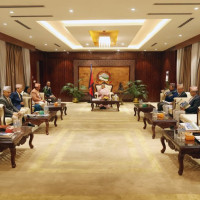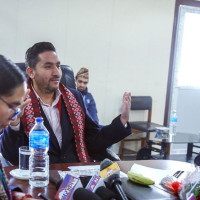- Saturday, 10 January 2026
Melting glaciers: Nepal in climate hot spot
Kathmandu, Nov. 12:As the temperatures continue their relentless rise on a global scale, the majestic glaciers of the Himalayas are undergoing an yet alarming transformation. These frozen giants, which are not only natural wonders but also lifelines for communities that depend on glacier melt for sustenance and power generation, are declining at a shocking rate.
United Nations Secretary-General António Guterres during his recent visit to Nepal highlighted the grave impact of climate change on the people of Nepal, emphasising their lack of responsibility for the crisis. He expressed his concerns that Nepali citizens are enduring the consequences of a situation they did not committed.
The UN chief observed that the accelerated melting of glaciers, the vital water source for downstream communities, is inflicting significant losses to the people of Nepal and beyond. Guterres emphasised the pressing necessity to confront the repercussions of climate change, stating, “It’s time to halt the madness of climate change.”
Of course, we are not far from the situation as described by UN Secretary-General Guterres. The evidence is all around us: Over the past decade, glacier melt has surged by a staggering 65 per cent, outpacing the previous decade. This alarming trend, unveiled through intricate analysis of glacier mass balance, is casting a shadow of uncertainty over the future water supply in the region. Rising temperature and the melting of glaciers have raised a serious question about the ability of these communities to weather the storm and secure their survival from the impacts.
While addressing the joint session of the Federal Parliament in Kathmandu recently, the UN Secretary General highlighted the alarming situation in the Himalayas, saying “Glaciers are melting at record rates. I was a witness.”
Before addressing the Parliament, Guterres had flown to Everest region and toured the Annapurna Base Camp (ABC). He also noted the devastating effects of this phenomenon, including potential glacial lakes bursting, flash floods in rivers, sea level rise, threats to cultures, and the exposure of mountainsides which increases the risk of rock slides, landslides and avalanches.
What the Secretary-General said in his address must come as an eye opener for the policy makers and leaders in Nepal, who have not yet taken serious measures to mitigate the impact of climate changes in the mountains.
Guterres emphasised the need to put an end to the age of fossil fuels to protect people on the frontlines of climate change-induced destruction. “We must act now to limit global temperature rise to 1.5°C in order to avert the worst of climate chaos. The world cannot wait,” he cautioned.
As noted by Secretary-General Guterres after his visit to the Everest region, Nepal is confronting highly challenging situations and grappling with an increased number of disasters in recent years. The nation is contending with frequent landslides and floods, impacting both mountainous districts and lowland areas.
Alarm bell ringing
Talking to The Rising Nepal about the devastated situation in the Himalayas, Dr. Miriam Jackson, Senior Cryosphere Specialist at the International Centre for Integrated Mountain Development (ICIMOD), said that the rapidly melting glaciers in the Hindu Kush Himalaya region is raising alarm bells, as they pose an imminent threat to the water supply for numerous communities.
“The climate is getting warmer, and this is having a huge effect on the glaciers, which are dependent on temperature, especially during the warm/melting season, and the amount of snowfall they receive. As temperatures increase, the glaciers melt more and become smaller. In the short term, there is an increase in water from the glacier due to ice melt, but as the glacier continues to shrink, at some point, the amount of water from the glacier decreases,” Dr. Jackson, who is also the lead author of High Mountain Areas in the IPCC Special Report on the Ocean and Cryosphere in a Changing Climate (SROCC) in 2019, said.
Similar are the views of Dr. Sudeep Thakuri, Associate Professor at the Central Department of Environmental Science at Tribhuvan University. He said that glacier melt is an indicator of ongoing climate change. According to him, in Nepal (central Himalayas), the glacier’s surface area has decreased by about 15 per cent in the last 50 years.
Dr. Thakuri said, with 2 degrees Celsius of warming from preindustrial temperatures, it is projected that 30 to 50 per cent of glacier ice volume may be lost by 2100. Nepal’s Himalayas, both in the central and eastern regions, are particularly vulnerable to higher level of ice loss due to their unique topography and high elevation.
Manjeet Dhakal, Head of the LDC Support Team at the Climate Analytics (CA) and Director for Climate Analytics South Asia Office, stressed that Himalayan glaciers are melting faster than expected, leading to rising sea levels and impacting regional water resources. This aligns with recent Intergovernmental Panel on Climate Change (IPCC) findings. As the Conference of Parties (COP28) is approaching, it is crucial to emphasise the urgent need for reduction of global emissions and support for Himalayan adaptation initiatives, including early warning systems, data exchange, and livelihood support.
According to Dhakal, international cooperation is crucial for addressing the challenges in the Himalayan region. Partnerships should focus on sustainable development, livelihood opportunities, technology transfer and capacity building, he said,
Enhanced regional collaboration in early warning systems, data sharing, disaster risk reduction, water management and sustainable agriculture can have a profound impact.
Dr. Thakuri said, “The global changes and issues in the Himalayas are not solely local concerns; they are interconnected with the global challenges. Since humans are the root cause of these problems, it is our responsibility to seek solutions. While expecting immediate improvements may be challenging, gradual and persistent efforts can undoubtedly enhance the situation. Collaborative work is essential to shape a better future.”
In reference to the recent address by the UN Secretary-General concerning mountain issues, he said that the voice of the UN Secretary-General on the climate change holds significant importance and has drawn global attention. “This underscores climate change as a top global priority. This recognition can bolster international efforts to mitigate the impacts of climate change and bring attention to this region of the world,” he added.
COP28 agenda: Urgent action
As COP28 is taking place this month, Dr. Thakuri said that addressing glacier issues at COP28 requires a comprehensive strategy that combines scientific evidence, regional and local impacts, adaptation and mitigation solutions, international cooperation, and a strong emphasis on urgency. By effectively advocating for the protection of glaciers, you can contribute to global efforts to combat climate change and its impacts.
Dhakal said, “The Secretary-General stressed the need to address climate change in mountainous areas, showing the urgency for global action to protect these vulnerable ecosystems. This marks an important step in the fight against climate change. It’s worth noting that this might be the first time climate change has been extensively discussed in Nepal’s Parliament. The Secretary-General praised Nepal’s efforts in climate-friendly initiatives and contributions to international climate negotiations.”
As we approach COP28, the Secretary-General’s message offers valuable support for Nepal’s global efforts to combat climate change, Dhakal added.
Collaboration is essential across all sectors and among countries to reduce carbon footprints, enhance the efficiency of tools and technologies, maintain continuous monitoring of mountain activities to strengthen knowledge and gather data on the impacts of global warming and human activities in these regions. Additionally, it’s crucial to establish early warning systems to save and properties of mountaineers, visitors, and the local communities residing in the vicinity or downstream valleys, Dr. Thakuri said.
Burning Issue of HKH
Discussing the UN Secretary-General’s address, Dr. Jackson commented, “This was an excellent opportunity for the world to witness the rapid changes occurring in the Hindu Kush Himalayas (HKH) and it truly brought attention to the region. Conflict can often arise due to involuntary migrations, water shortages, and various hazards. While it may be challenging to immediately connect climate change to conflict, a closer examination reveals numerous instances of such links. “The UN is involved in a wide range of areas, including refugees, conflict resolution, heritage preservation, healthcare, and more, and all of these will be affected by climate change, particularly the alterations in the cryosphere and mountain regions,” he said.
“We at ICIMOD are measuring a general trend that glaciers are melting more in the past decade. If we compare the most recent decade (2010-2019) with the decade before (2000 – 2009), the melting rate has increased by 65 per cent. It is still relatively small – 0.28 meters water equivalent per year average for the whole of the Hindu Kush Himalaya. ‘Meters water equivalent’ means the amount of ice from the glacier if you converted the ice to snow. However, in the decade before it was 0.17 metres water equivalent, so a significant increase, especially if it continues to rise.”
The graphic shows the average glacier mass balance (mass balance is a measure of the ‘health’ of a glacier) for each river basin in the HKH for three different periods: 1975-1999, 2000 – 2009, and 2010 – 2019.
Funds for loss and damage
Dr. Buddhi Sagar Poudel, Chief of the Climate Change Management Division under the Ministry of Forest and Environment, said that as COP 28 is approaching, we are confident in raising the issues of mountains and asking for funding for loss and damage. “After the address of the UN Secretary-General following his visit to Everest region, we are more confident in bringing our concerns to the world and bargaining for loss and damage funds,” he said.
According to Dr. Jackson, it is certainly possible to secure funds for loss and damages if there is enough willpower. We hope that by presenting evidence of the ongoing changes and their resulting impacts, this can become a reality. “Many mountain communities, which are the most severely affected by glacier and snow cover changes, are the ones who have contributed the least to greenhouse gas emissions causing climate change. Yet, they are suffering the most.”



-original-thumb.jpg)

-square-thumb.jpg)
-original-thumb.jpg)










